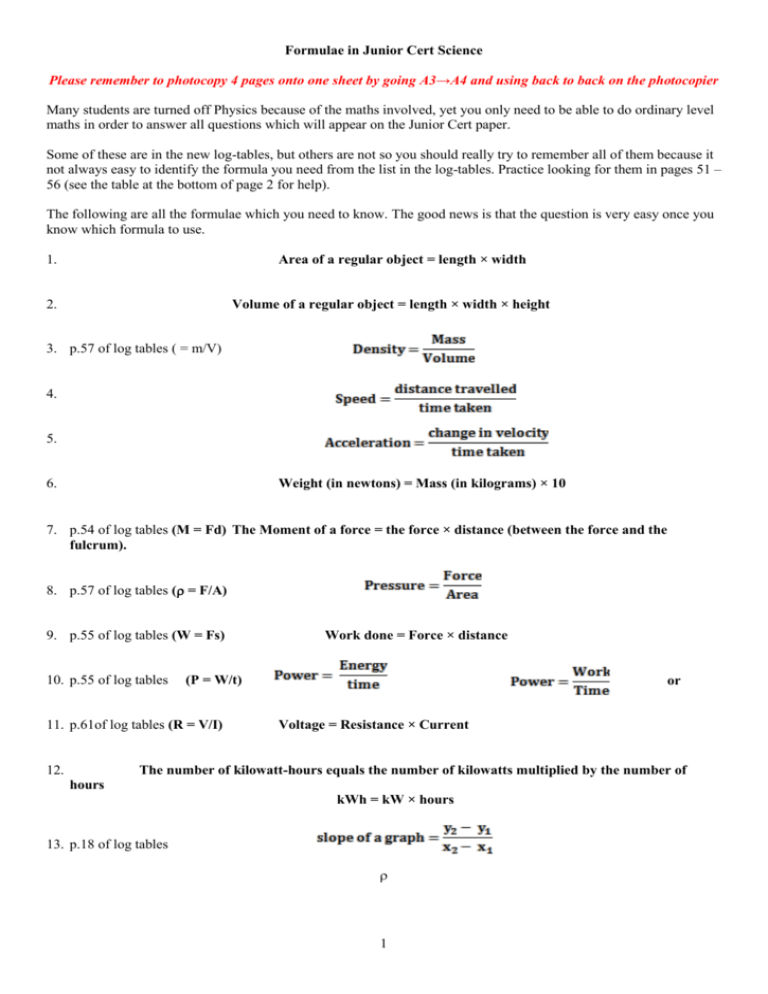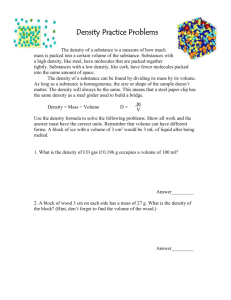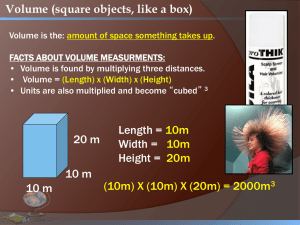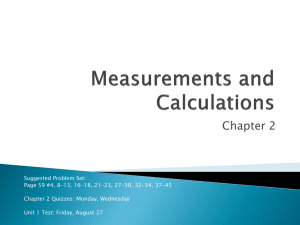word - Physics Teacher
advertisement

Formulae in Junior Cert Science
Please remember to photocopy 4 pages onto one sheet by going A3→A4 and using back to back on the photocopier
Many students are turned off Physics because of the maths involved, yet you only need to be able to do ordinary level
maths in order to answer all questions which will appear on the Junior Cert paper.
Some of these are in the new log-tables, but others are not so you should really try to remember all of them because it
not always easy to identify the formula you need from the list in the log-tables. Practice looking for them in pages 51 –
56 (see the table at the bottom of page 2 for help).
The following are all the formulae which you need to know. The good news is that the question is very easy once you
know which formula to use.
1.
Area of a regular object = length × width
2.
Volume of a regular object = length × width × height
3. p.57 of log tables ( = m/V)
4.
5.
6.
Weight (in newtons) = Mass (in kilograms) × 10
7. p.54 of log tables (M = Fd) The Moment of a force = the force × distance (between the force and the
fulcrum).
8. p.57 of log tables ( = F/A)
9. p.55 of log tables (W = Fs)
10. p.55 of log tables
(P = W/t)
11. p.61of log tables (R = V/I)
12.
Work done = Force × distance
or
Voltage = Resistance × Current
The number of kilowatt-hours equals the number of kilowatts multiplied by the number of
hours
kWh = kW × hours
13. p.18 of log tables
1
Units
You must know the units of each of the quantities listed below.
Time
Distance
Velocity / speed
Acceleration
Mass
Volume
Density
Weight
Force
Pressure
Work
Energy
Power
Current
Voltage
Resistance
seconds
metres
metres per second
metres per second
squared
kilograms
metres cubed
grams per centimetre
cubed
newtons
newtons
pascals
joules
joules
watts
amps
volts
ohms
s
m
m/s
m/s2
kg
m3
g/cm3
N
N
Pa
J
J
W
A
V
Test yourself –what formula connects the following variables?
Page in log tables
57
mass
volume
density
velocity
time
distance
change in
velocity
× 10
acceleration
time taken
mass
weight
force
distance
pressure
moment of a
force
force
area
57
distance
force
work done
55
time
work
power
55
voltage
resistance
current
61
kW
hrs
kWhrs
density = mass/volume
Area =
Volume =
Slope of a line =
2
Test yourself – complete the table below
Quantity
Time
Distance
Velocity / speed
Acceleration
Mass
Volume
Density
Weight
Force
Pressure
Work
Energy
Power
Current
Voltage
Resistance
Unit
seconds
Symbol
s
Units Crossword
Across
2.
Units of work or energy. (6)
4.
Units of mass. (9)
6.
Units of power. (5)
8.
Units of current. (4)
9.
Units of area (6, 7).
11.
Units of distance. (6)
12.
Units of potential difference
(or volts). (5)
Down
1.
Units of speed (6, 3,6).
3.
Units of pressure. (7)
5.
Units of force. (7)
7.
Units of resistance. (4)
10.
Units of time. (7)
3
Junior Cert Science Maths Questions – some of the questions have been altered slightly from the original context.
Mass, Volume and Density
1. [2008 OL]
If the mass of a stone is 20 g and the volume of the stone is 10 cm3, find the density of the stone.
2.
[2007 OL]
A block of metal has the measurements shown on the right.
The mass of the metal block is 21 g.
(i) What is the volume of the block?
(ii) What is the density of the block?
3. [2009 OL]
The mass of a metal block is 14.7 g. It has a volume of 7 cm3.
Calculate the density of the block.
Give the units of density with your answer.
4. [2009]
A pupil measured the volume of a potato using the items of laboratory equipment,
labelled A and B as shown in the diagram.
The potato had mass 175 g and volume 125 cm3.
Calculate the density of the potato.
Give the units of density with your answer.
Solutions
1.
(i) Density = Mass ÷ Volume = 20 ÷ 10= 2 g/cm3
2.
(i) Volume = 2 ×1 × 5 = 10 cm3
(ii) Density = Mass ÷ Volume = 21 ÷ 10: 2.1 g/cm3
3. Density = 14.7÷7 = 2.1 g/cm3
4. Density = 175÷ 125 = 1.4 g/cm3
Velocity and Acceleration
1. [2007 OL]
The speed of a car is 15 m/s. What distance will the car will travel in 5 seconds?
2. [2009 OL]
(i) A cyclist moves 20 metres along a track in 4 seconds.
Calculate the speed of the cyclist.
(ii) Calculate the distance the cyclist will travel in 2 seconds.
Solutions
1. Distance = speed × time = 15 × 5 = 75 m
2. Speed = distance ÷ time = 20 ÷ 4 = 5 m/s
Distance = speed × time = 5 × 2 = 10 m
Force
1. [2009]
A stone has a mass of 2 kg. What is the weight of the stone on earth? Give the unit.
Solution
1. Weight = mass × 10 = 2 × 10 = 20 Newtons.
4
Moment of a force
1. [2007]
The diagram shows a metre stick suspended from its centre of
gravity.
A force of 3 N acts on the stick at the 90 cm mark and a force
of F newtons acts on the stick at the 20 cm mark. The metre
stick is balanced horizontally.
Calculate force F.
Solution
1.
Moment clockwise = moment anti-clockwise {and moment of a force = force × distance]
3 × 40
= F × 30
120 = 30 F
F = 120 ÷ 30
F=4N
Pressure
1. [2006 OL]
Give the formula for calculating pressure.
2. [2009 OL]
Answer the following questions about pressure.
A metal block applies a force of 20 N on an area of 5 cm2. Find the pressure being applied by the block.
Solutions
1. Pressure = Force ÷ Area
2. Pressure = 20 ÷ 5 = 4 Pa
Work, Energy and Power
1. [2007]
The driver of a moving car applied the brakes.
The brakes produced an average stopping force of 8 kN (8000 N) and the car stopped having travelled 20 m after
the brakes were applied.
Calculate the work done in stopping the car.
2. [2006]
A girl of mass 60 kg (weight 600 N) climbed a 6 m high stairs in 15 seconds.
Calculate the work she did and the average power she developed while climbing the stairs.
Solutions
1. Work (= force × distance) = 8000 × 20 = 160000 J
2. Work (= force × distance) = 600 × 6 = 3600 J.
Power (= work ÷ time) = 3600/15 = 240 W.
Electricity
1. [2006]
Calculate the resistance of the filament of a car headlamp when 12 V produces a current of 5 A in it.
In what unit is resistance measured?
2. [2007 OL]
An electric cooker has four hot plates.The total power rating of the four hot plates is 7 kW.
All four are used for a total of 2 hours each day.
(i) How many units of electricity (kWh) are used in 1 week?
(ii) If electricity costs 11 cent per unit how much does this cost?
5
3. [2006 OL]
The ESB charges for electricity at a rate of 12 cent per kW h.
A tumble drier of power rating 2.5 kW is used for 2 hours each week for 4 weeks.
(i) How many units of electricity are used?
(ii) What is the cost, in cent, of using the tumble drier?
Solutions
1. R = V ÷ I = 12÷ 5 = 2.4 Ohms (2.4 Ω)
2.
(i) 7 × 2 × 7 = 98 units
(ii) 98 × 11 = €10.78
3.
(i) 2.5 × 2 × 4 = 20 units.
(ii) 20 × 12 = 240 cent
6
Practice Questions
1. A stone has a mass of 120 g and a volume of 20 cm3, what is the density of the stone?
2. The density of Iron is 8 g/cm3. Calculate the mass of 6 cm3 of Iron.
3. What is the volume of an object which has a mass of 20 g and a density of 4 g/cm3?
4. Calculate the velocity of a swimmer who swims 100 m in 20 seconds.
5. Calculate the distance travelled by a teacher who runs at a speed of 5 m/s in for 3 s.
6. How long does it take a girl to travel 1000 m, if her speed is 2 m/s?
7. When a girl was a certain distance from a high cliff she shouted loudly. One and a half seconds later the echo
returned from the cliff. How far was the girl from the cliff? (take the speed of sound to be 340 m/s).
8. What are the units of velocity?
9. One car can go from 0 to 100 m/s in 10 seconds while another car which can go from 100 m/s to 150 m/s in 3
seconds. Which car has the greater acceleration?
10. What are the units of acceleration?
11. Calculate the weight (in Newtons) of a bag of sugar, which has a mass of 5 kg.
12. A man has a mass of 100 kg. What is his weight?
13. Would the man weigh less or more on the moon?
14. Why does the man have a different weight on the moon?
15. A force of 75 N is used to turn the spanner in the diagram. If the distance between the force
and the nut is 10 cm calculate the moment of the force.
16. A wrench 50 cm long is used by a mechanic to turn a nut.
If the force he exerts on the end is 4 Newtons, calculate the moment of the force.
17. A boy held a book of weight 20 Newtons in his fully outstretched hand, at a distance of 50 cm away. Calculate the
moment of the force.
18. Beyonce weighs 500 N and is sitting at one end of a see-saw which is 4 m long and balanced in the middle.
Jordan is 2000 N. Where should she sit in order to balance the see-saw?
19. If a metal block applies a force of 20 N on an area of 5 cm2, find the pressure being applied by the block.
20. Calculate the area of the base of a wooden box, which weighs 48 newtons if the pressure exerted is 12 pascals.
21. A girl of mass 50 kg (weight 500 N) climbed a 7 m high stairs in 20 seconds.
Calculate the work she did and the average power she developed while climbing the stairs.
22. A force of 30 N was used to pull a sofa 4 metres across a room. How much work was done?
23. If the time taken in the previous question was 20 seconds, calculate the average power.
24. A weight-lifter lifted a weight of 1000 N a distance of 1.5 metres. How much work was done?
25. If the time taken in the previous question was 2 seconds, calculate the average power.
7
26. Complete the table below
Voltage
10
120
100
Current
5
2
Resistance
200
30
2
0.5
20
10
120
27. The ESB charges for electricity at a rate of 11 cent per kW h.
A hair-drier of power rating 1.5 kW is used for 20 minutes each day.
(i) How many units of electricity are used?
(ii) What is the cost, in cent, of using the hair- drier for six days?
Watts
(W)
50
20
1000
500
60
kilowatts
(kW)
0.05
Hours
(Hr)
60
5
1 day
10 minutes
1 week
8
kWhr
3
Cost
(12 cent per unit)
24







